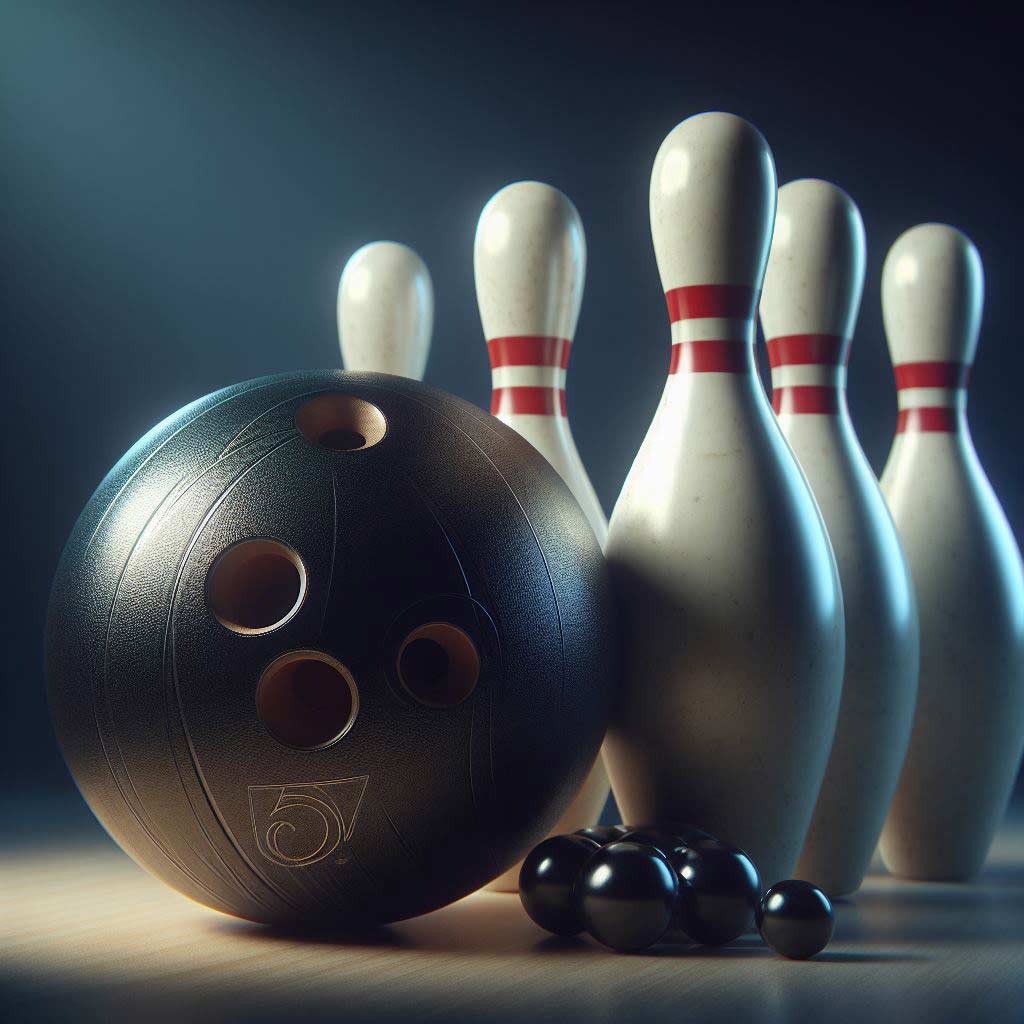If you’re familiar with the classic 10 pin bowling, you might be wondering – what exactly is 5 pin bowling? While the two share some core similarities, 5 pin bowling is a distinct and unique variant with its own rules, equipment, and gameplay.
In this comprehensive guide, we’ll dive into the details of 5 pin bowling – from its history and origins to the key differences compared to the more widely known 10 pin version.
We’ll cover the essential equipment, explain how to play the game, explore popular strategies and techniques, and even touch on the world of competitive 5 pin bowling tournaments and events.
Whether you’re a seasoned bowler looking to try something new or a complete beginner, this article will provide you with all the information you need to get started and understand the fascinating world of 5 pin bowling.
What is 5 Pin Bowling?
5 pin bowling is a variant of the classic bowling game that originated in Canada in the early 1900s. Unlike the standard 10 pin bowling, which uses a larger ball and 10 pins arranged in a triangle formation, 5 pin bowling utilizes a smaller ball and just 5 pins set up in a square arrangement.
The roots of 5 pin bowling can be traced back to 1909, when Canadian bowling alley owner Thomas F. Ryan came up with the idea to modify the traditional 10 pin game.
Recognizing that the hefty 10 pound bowling balls used in the original version were a bit too much for the average player, Ryan devised a new setup with lighter 3 pound balls and fewer, smaller pins.
This adjustment made the game more accessible and enjoyable for casual bowlers, while still maintaining the core thrill and challenge of knocking down pins. Over the years, 5 pin bowling grew in popularity, especially across Canada, and has developed its own unique culture and competition scene.
The 5 Pin Bowling Equipment
At the heart of the 5 pin bowling experience is the specialized equipment used in the game. Let’s take a closer look at the key elements:
The 5 Pins
The most obvious difference between 10 pin and 5 pin bowling is the number and arrangement of the pins. In 5 pin, there are only 5 pins set up in a square formation, as opposed to the triangle setup of the standard 10 pins.
Each 5 pin is approximately 5 inches tall and 2.5 inches in diameter, made of a lightweight material like plastic or wood. The pins are arranged with one pin in the center, surrounded by the other 4 in a square configuration, spaced about 16 inches apart.
The Bowling Ball
Another key distinction is the size and weight of the bowling ball used in 5 pin bowling. Whereas 10 pin balls can weigh up to 16 pounds, the 5 pin ball is much smaller and lighter, typically ranging from 3 to 6 pounds.
The 5 pin ball is also slightly different in shape, with a slightly larger diameter and a more rounded, less elongated form compared to standard 10 pin balls. This allows for easier gripping and control, especially for bowlers with smaller hands or less upper body strength.
Other Equipment
Beyond the pins and ball, 5 pin bowling also utilizes some specialized lane and footwear equipment:
- Approaches – The approach areas at 5 pin alleys are typically shorter than 10 pin, around 12-15 feet long.
- Gutters – The gutters on 5 pin lanes are narrower, about 6-8 inches wide, compared to the wider 10 pin gutters.
- Bowling Shoes – 5 pin bowlers wear specialized shoes with sliding soles to help with their delivery.
How to Play 5 Pin Bowling
The objective of 5 pin bowling is simple – knock down as many of the 5 pins as possible in each frame. However, the gameplay and scoring have some key differences from the 10 pin version.
The Frame Structure
A standard game of 5 pin bowling consists of 10 frames. In each frame, the bowler has 3 rolls (or ‘shots’) to knock down the 5 pins.
The scoring works as follows:
- If the bowler knocks down all 5 pins with the first roll, it’s called a “strike” and worth 15 points.
- If some pins remain after the first roll, the bowler gets 2 more rolls in that frame to try and knock down the remaining pins.
- The total number of pins knocked down over the 3 rolls is the bowler’s score for that frame.
- If the bowler knocks down all 5 pins with the 2nd or 3rd roll, it’s called a “spare” and worth 10 points plus the number of pins knocked down on the next roll.
Bowling Technique
The delivery and technique in 5 pin bowling shares some similarities with 10 pin, but also has some distinct differences:
- Stance – 5 pin bowlers typically have a more upright, less crouched stance compared to 10 pin.
- Approach – The shorter approach area means 5 pin bowlers take fewer steps before releasing the ball.
- Release – 5 pin bowlers generally use a more controlled, less powerful release to guide the ball.
- Aim – The goal is to hit the center pin solidly to maximize the “scatter” effect and knock down surrounding pins.
Scoring and Strategy
Scoring in 5 pin bowling is also a bit different from 10 pin. The maximum score in a single frame is 15 points (a strike), and the highest possible game score is 450 points (15 strikes).
Strategies in 5 pin revolve around accuracy and control rather than sheer power. Bowlers need to carefully aim for the center pin, use spin and hook shots to knock down surrounding pins, and capitalize on spares to rack up points. Managing the narrower gutters and lighter ball also requires more precision.
5 Pin Bowling Gameplay and Strategy
Beyond the basics of how to play, experienced 5 pin bowlers develop a variety of advanced techniques and strategies to maximize their scores.
Targeting the Center Pin
Since the 5 pin configuration has a single central pin, the most effective approach is to aim directly for this “money” pin. Hitting it solidly will cause the surrounding pins to scatter, dramatically increasing the chances of a strike or spare.
Skilled 5 pin bowlers use various ball release techniques, like putting more hook or spin on the ball, to steer it towards the center pin at the ideal angle. Mastering this precision targeting is crucial for success in the game.
Managing the Narrow Gutters
One of the key challenges in 5 pin bowling is navigating the relatively narrow gutters on either side of the lane. Balls that stray too far to the left or right risk falling into the gutters, resulting in a “gutter ball” and zero pins knocked down.
To avoid this, 5 pin bowlers need to develop a controlled, accurate delivery that keeps the ball traveling straight down the center of the lane. Subtle adjustments in stance, approach, and release can help maintain this straight-line trajectory.
Capitalizing on Spares
Since a strike is worth a maximum of 15 points in 5 pin bowling, converting spares becomes extremely important for racking up a high score. When a bowler knocks down 4 pins on the first roll, the remaining 2 rolls in that frame provide an opportunity to get a spare worth 10 points plus the next roll’s score.
Experienced 5 pin players dedicate significant practice time to honing their spare-shooting abilities, finding the optimal angles and techniques to consistently knock down the remaining pins.
Leveraging Spin and Hook
Another strategic element in 5 pin bowling is the use of spin and hook shots. By imparting rotation on the ball, bowlers can make it curve and “hook” towards the center pin, increasing their chances of a strike or spare.
This type of finesse shot requires excellent ball control and a finely tuned technique. Mastering spin and hook shots allows 5 pin bowlers to overcome challenges like difficult pin configurations or tough lane conditions.
Tips for 5 Pin Bowling Beginners
If you’re new to the world of 5 pin bowling, here are some essential tips to help you get started:
- Find the Right Ball Weight: Experiment with different ball weights, starting on the lighter end around 3-4 pounds, to determine what feels most comfortable and controllable for your strength and skill level.
- Develop Consistent Technique: Focus on establishing a smooth, repeatable approach, stance, and release. Proper form is crucial in 5 pin bowling, where precision is key.
- Practice Accuracy over Power: While you’ll want to generate enough force to knock down the pins, accuracy should be your primary focus, especially when starting out. Aim for the center pin consistently.
- Learn Spare Shooting: Dedicating time to mastering your spare-shooting abilities will pay huge dividends in your 5 pin bowling scores. Work on finding the optimal angles and release.
- Experiment with Ball Spin: As you progress, start incorporating more hook and spin on your deliveries to take advantage of the 5 pin configuration and narrow gutters.
- Observe Experienced Bowlers: Watch how seasoned 5 pin players approach the game. Pick up on their techniques, strategies, and ways of reading the lane conditions.
- Have Fun and Stay Patient: 5 pin bowling has a learning curve, so approach it with patience and a spirit of enjoyment. The more you play, the more your skills will improve.
Competitive 5 Pin Bowling
While 5 pin bowling may not have the same global recognition as its 10 pin counterpart, the sport has a thriving competitive scene, particularly in Canada where it originated.
The Canadian 5 Pin Bowlers’ Association (C5PBA) is the governing body that oversees tournaments, leagues, and national championships at both the amateur and professional levels. Major events include the Canadian 5 Pin Bowling Championships, which has been held annually since 1938.
At the competitive level, 5 pin bowling features some key differences from recreational play:
- Scoring Systems – In tournaments, the scoring may use a different point system beyond the standard 15 points per strike.
- Lane Conditions – Competitive lanes are often more heavily oiled, requiring advanced techniques to handle the increased friction.
- Equipment – Competitive bowlers may use specialized balls, shoes, and other gear optimized for their skill level.
- Strategy – Tournament-level 5 pin bowling places a greater emphasis on deep strategic analysis of lane conditions, ball dynamics, and opponent tendencies.
While the fundamentals of the game remain the same, the world of competitive 5 pin bowling demands an even higher level of technical mastery, mental focus, and adaptability from its top players.
Conclusion
In the vast world of bowling, 5 pin stands out as a distinct and captivating variant that offers a unique challenge and experience for players of all skill levels. With its specialized equipment, distinct gameplay, and rich competitive scene, 5 pin bowling provides an engaging alternative to the more widely known 10 pin format.
Whether you’re a seasoned bowler looking to expand your horizons or a complete newcomer drawn in by the allure of this Canadian bowling tradition, diving into the world of 5 pin is a thrilling proposition.
By understanding the fundamentals, mastering the techniques, and embracing the strategic depth of this game, you’ll unlock a whole new level of bowling enjoyment and fulfillment.
So grab a lightweight ball, step up to the shorter approach, and get ready to take on the 5 pin challenge. Who knows – you might just discover a new bowling passion that will have you coming back to the lanes time and time again.





